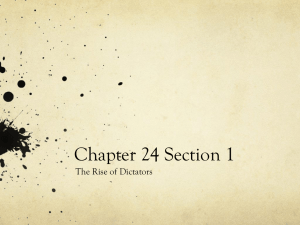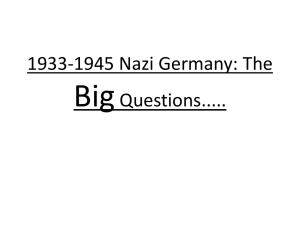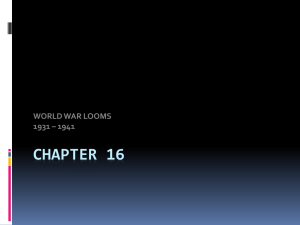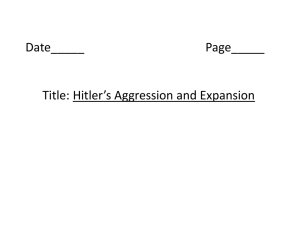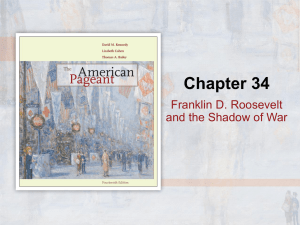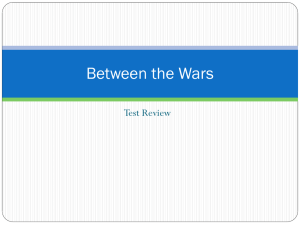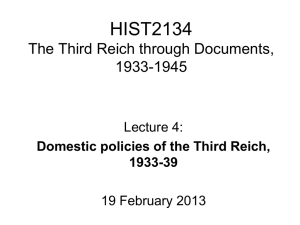Triumph des Willens
advertisement
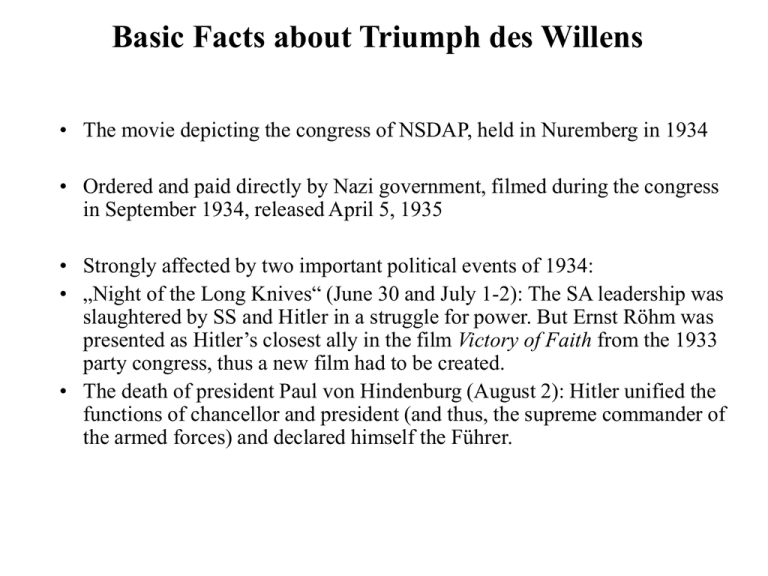
Basic Facts about Triumph des Willens • The movie depicting the congress of NSDAP, held in Nuremberg in 1934 • Ordered and paid directly by Nazi government, filmed during the congress in September 1934, released April 5, 1935 • Strongly affected by two important political events of 1934: • „Night of the Long Knives“ (June 30 and July 1-2): The SA leadership was slaughtered by SS and Hitler in a struggle for power. But Ernst Röhm was presented as Hitler’s closest ally in the film Victory of Faith from the 1933 party congress, thus a new film had to be created. • The death of president Paul von Hindenburg (August 2): Hitler unified the functions of chancellor and president (and thus, the supreme commander of the armed forces) and declared himself the Führer. Propaganda Techniques: Religion In the beginning, the flight and landing of Hitler’s airplane in Nuremberg clearly evocates the impression of „god’s descent to the earth“. Hitler was probably the first politician to use airplane in such scale. Propaganda Techniques: History Fleet of Hitler’s cars continues to the center of Nuremberg through rallying crowds, with Hitler evoking Roman Imperator (or a „pillar striking through the mass“), while the overall scene shows connection of glorious history and strong present. Propaganda Techniques: Symbols The movie is full of symbols of National Socialism, NSDAP and Germany, not only various forms of the Swastika (usually on flags and banners), but also the German Eagle, which was modified to „Nazi-style“. Propaganda Techniques: Fire Fire was an important attribute of the Nazi movement, symbolizing the dynamism, revolution and „action-style“. The night marches of SA-men carrying torches and launching fireworks are shown in the movie several times. Propaganda Techniques: Labor Trying to get wide support and „overcome class differences“, the Nazis were often promoting manual work as a part of „the struggle for the nation“. In the movie, the scene of RAD (Nazi labor service) illustrates this. (The well-known quote „Hitler has built motorways“ is nothing but true.) Propaganda Techniques: Masses There are many mass scenes showing NSDAP sub-organizations such as the SA, SS, RAD and Hitlerjugend. The enormous formations not only show wide support for the NSDAP and the „national unity“, but their geometric shapes should also symbolize „the victory of the order over the chaos“. Propaganda Techniques: Führer Adolf Hitler is depicted as a „super-human being“, overtopping all the other people. Many shots were taken from below with Hitler standing on a huge firm object, thus looking like a „mountain“ towering over the devoted masses. Propaganda Techniques: Speeches „Die Partei ist Hitler! Hitler aber ist Deutschland, wie Deutschland Hitler ist!“ „The Party is Hitler! But Hitler is Germany, as Germany is Hitler!“ „Vor uns liegt Deutschland, in uns marschiert Deutchsland und hinter uns kommt Deutschland!“ „In front of us Germany lies, within us Germany marches and after us Germany comes!“ „In jede Stunde, an jedem Tag, nur zu denken an Deutschland, an Volk und an Reich! An unsere deutsche Nation und den deutsche Volk! Sieg Heil!“ „Every hour, every day, think only of Germany, the people and the empire! To our German nation and German People! Hail to the victory!“ The speeches delivered in the movie by Hitler and other Nazi leaders are usually short and simple, but very striking. They contain clear messages about features and goals of the National Socialism and quotes about all the main features of the movement and the movie: power, unity, nation… Conclusion and Critique Riefenstahl often stated that it was only a „documentary movie about the congress of the ruling political party“, but the truth is that the congress of NSDAP was organized just for the making of the movie, and the purpose was entirely propagandistic. The impact on German public was enormous and the movie was extremely successful. It started to gain net profit in two months after opening, which was absolutely fantastic result in that time. Usually considered the best propagandistic movie ever made. In that time, it received many foreign prizes and awards. And what is probably even more interesting, the DVD version is still making money! (The film is prohibited in certain countries, e.g. in Germany.) For us now, Nazism is connected with terror, war and holocaust, but we can imagine that ordinary people were fascinated in 1934. Conclusion and Critique The movie is built on „masses“, while present society is individualistic, thus the impact on current viewer is significantly weaker. The mass scenes (such as SA or RAD marches) seem quite boring now. However, certain sequences are still (and probably will forever be) fearfully thrilling, e.g. the opening flight and ride through Nuremberg, the honoring of the „Beer Putsch“ victims or Hitler’s speeches. From the purely technical point of view, Triumph des Willens is surely an exceptional masterpiece, which strongly influenced film-making in the 20th century, and scenes in many well-known movies (such as Star Wars or The Lord of the Rings) are apparently inspired by it. Triumph des Willens, from both ideological and technical point of view, is one of the best managed and most influential movies of all time. Sources Triumph des Willens (http://www.youtube.com/watch?v=GcFuHGHfYwE). Bach, Steven: Leni Riefenstahlová – Život a dílo „Hitlerovy filmařky“, Praha, Euromedia Group, k. s. – Ikar 2007. Leni Riefenstahl (http://en.wikipedia.org/wiki/Leni_Riefenstahl). Triumph des Willens – Triumf vůle (http://nacismus.mysteria.cz/program/triumf.php). Triumph of the Will (http://en.wikipedia.org/wiki/Triumph_of_the_Will). Vlnas, Martin: Triumf vůle jako vrchol nacistické propagandistické kinematografie (http://www.globalpolitics.cz/clanky/triumf-vule). Vlnas, Martin: Triumf vůle – nacistická propaganda nebo nadčasová kinematografie (http://vlnas.blog.respekt.cz/c/1474/Triumf-vule-nacistickapropaganda-nebo-nadcasova-kinematografie.html).


